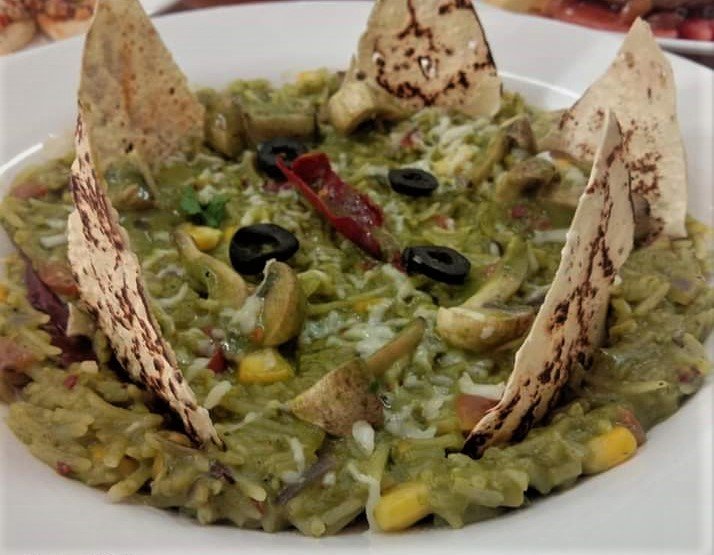THE TREND OF FUSION COOKING,Understanding The Basic Fundamentals To Fuse & Not Confused By Celebrity Master Chef Kaviraj Khialani.
/





THE TREND OF FUSION COOKING Understanding The Basic Fundamentals To Fuse & Not Confuse
It seems and appears really fascinating these days when a lot many of us start to feel and realize that cooking is fun at times and we can try to use our minds and ideas to dish out new concepts, variations and flavors onto our plates and invite loads of compliments! Sounds good indeed but the real practical approach towards just mixing things together doesn’t always really work.
Experience and understanding your ingredients, your passion to bring out the complimenting concoctions do need to find their perfect equations into that dish before it gets plated and appeal to the eyes of its truly deserving connoisseur.
I came across this word fusion since almost two decades now where people from home cooks to the aspiring to be chefs and a few foodies shared thoughts and ideas where for some it happened by accident and for some it turned out to be disasters as well for the first time. It’s a mixed bag of emotions and experiences that people speak about when it comes to something new! There is a segment of the foodie market that is not at all able to digest and accept this trend while some percentage goes for it feel the changing concept and to some the mere concept of it only is quite mesmerizing.
Let us try and understand this concept in a little more detail:
What does Fusion mean?
The concept of Fusion refers to the combination of flavors, and aromas to gel them up well to create something variant and new in order to appeal to and excite our senses and create a new experience of eating and enjoying the open-mindedness of the person working on with his experience and creativity.
How did this concept of Fusion start up?
The concept of fusion is not new to us and it has been around since a few decades now it is believed that most parts of Asia and Europe started with this idea of doing something out of the box in order to have the guests try new touch with their routine cuisines also presenting a little bit of cross culture affiliations and inclusions into the dish.
What do I need to know before getting into fusion concepts?
Knowing your Basic of Cooking: I usually relate this with a very simple example like not knowing how to make a cup of tea and planning to pour out an herbal infusion based innovative cuppa full of confusions.
Need to Learn the ABC: to me Fusion has been ever exciting since many years and it refer it to as
A- Articulate, B- Believe, C – Compile: This simply means that we need to first chalk out the base cuisine which we want to work on, be sure on what changes/alterations are to be made on it and finally take notes on the same and then develop the recipe.
Follow an E – T – C Model:
E- Experiment, T- Taste, C –Change: These are of course the terms and codes designed by myself over the years as I worked on this trend and it made it easy for me to share it with budding chefs on how to relate to it. So firstly, we need to be able to put those compiled ideas into a practical lab/kitchen set up & work on it to make it come out the way we wanted it to for example if I want to try a fusion recipe like a Tex-Mex Stuffed Olive and Cheesy Makhana Koftas in Makhani Gravy using sun-dried tomatoes and fenugreek soil I need to make sure I do it step by step understanding the changes being made from the basic recipe to this new modified Italian & Mexican fused flavors into my gravy & koftas.
While doing this I will be taking note of all the changes and alterations happening in the saucepan and hopefully expect it to work with my final recipe. Once the dish is ready, I will plate it, garnish it as per my thoughts and check for Reality Vs Plan.
Once I have done the comparison I will look for any improvements if needed and make the necessary changes and re-schedule my trials.
Get a C –C – C Evaluation done for your dish:
C- Checking for taste.
C- Confirming on flavors.
C- Critical improvements if any.
This really works a lot since I still remember the first time I made a recipe with a fusion concept and upon doing a blind fold tasting with it, the results were surprisingly 90 % YES and a 10 % NO. what mattered more to me was the element of NO and the critical feedback is very important before we decide to finalise the dish to feature on our menu card of our restaurant.
I agree all of us have varied choice of tastes and flavors with foods but what ultimately matters are how successful it can be when it goes to the guest table and the feedback form/comments/its social media posting and coverage also needs to be thought about.
S O P your Fusion Concept: referring to a commonly used term here called standard operating procedure, which makes you maintain your recipe from start to end process and also shows stability and continued quality on the plate whenever it is being prepared and served. Once you have achieved your final plan as per reality check it becomes imperative to have the futuristic approach model ready for the same by documenting it with the revised final recipe plan, method, garnish and plating design, take photographs of your finished dish, also note on portion size as well how many gms, ml etc will be served per portion and of course it will lead to the costing of the dish in order to fix up its selling price if being used for a commercial purpose.
Which are some of the most common cuisines one can try for fusion combinations and which of them usually work well?
The varieties of cuisines are as long as we can imagine them to be, from the very basic like Indian cuisine, French cooking, Italian cooking, Mexican, Chinese, Japanese, English, American, Spanish, Filipino, Indonesian, Sri-Lankan and more! I started with Indian cooking and worked on it and my first ever recipe with fusion was a Dal-Khichdi, the wonder comfort food!
It was fun and a great experience working fusion with a dal rice combo with international flavors and watching it picking up well in the pan leaves back wonderful memories to cherish!
for Instance: Trying a Indo – Mexican Fusion Dal Khichdi having the lentils and rice soaked, cooked up, lightly mashed and tempered with garlic, herbs, peri-peri spice, tomato salsa, olives to top garnished with curry leaf and pepper dust, served with Aamchuri Avocado raita relish and Sprout – Cabbage salad with desi Achari dressing.
Another example which I feel like sharing with fusion is with desserts which most of us are fond of and love trying something new once in a while.
Desh- Videsh ki Mithaas: a fusion dessert with a combination of our desi rabdi being infused with cinnamon, blueberry and rose petal salsa layered with walnut brownie soil/crumble, stewed dragon fruit, topped with mini betel leaf samosa with a stuffing of Kiwi Gulkhand and Coconut –Cashew Praline.
Some of my tried and tested ideas with FUSION RECIPES:
Indo-Italian- Spanish Fusion Pasta Dum Biryani: Choice of pasta, bell peppers, mildly spiced cooked soy chunks or mini meatballs in Kadai masala, birishta, saffron cream veloute sauce, slivered almonds / pistachios, black and green olives rose water, fresh herbs like basil, coriander, grated cheese all layered up in a pot, sealed, given dum and served piping hot!
Indo- Filipino Mini Chicken Tortas [mini cutlets]: These are originally non-spicy made with pork mince, here I made it with chicken mince, onions, potatoes, garlic, oil cooked up together, spiced up with garam masala powder, crushed peppercorns, coriander, green chili, mixed herbs, chili flakes. Adding egg into the mixture and little grated cheese, they are spooned out into a pan with oil and shallow fried, golden browned and enjoyed with tomato ketchup but for now I did a pesto- peanut- coriander chutney to go with this fusion.
Indo- Italian- American Fusion: Western Lasagne Florentine Delight: in this concept we have two options For the pasta sheets, 1. We can use variety of flours and flavors, natural colors as well to make it different for example a chili tomato paste into a soy- whole wheat dough. 2. We can also use leftover chapattis, theplas as well being fusion.
For the fillings/layers for the lasagne we have multiple options as well in Fusion: 1. Assorted vegetable fillings-peas-potato subzi, stir fried veggies, Aloo Gobi, kadai mix veg, paneer bhurji etc. 2. For non-veg we have options as well like egg bhurji, scrambled eggs with chicken keema and cheese, mutton keema mattar, boiled cubes of chicken in Thai sweet chili, grilled sliced prawns in Achari masala. We also have a choice of using our tikkas and kababs as well into the lasagne concept.
We will also be needing our white sauce, cheese, olives, chili flakes, herbs, and baked beans to be spiced up with green chili, onions, garam masala and coriander leaves for this recipe. Once all is ready, we can start layering the dish for baking, with white sauce, pasta sheets, layers of veg- or non-veg options, cheese, spiced baked beans and repeat the layers. Finally temper it on top with oil, curry leaves, bohri red chilies, fresh herbs and top with grated cheese and bread crumbs, bake and serve.
Final Words of Advice: to me this topic is never ending and cooking and creativity are two sides of the same coin and the more we indulge the more we innovate is the key! I’m sure this would be a good eye opener for all those who always thought how to get started and create some impressions on people and loved ones. Fusion to me also has been an easy way since using leftovers also a good option and saves on time as well, what is most interesting is the final output on the plate and that first bite and not to forget the reactions and expressions, they are truly worth the watch! Remember to make good fusion you must not be confused but open to trying out new stuff!
So here’s wishing you all good luck for your fusion cooking, do try it for sure, it is extremely interesting working on it, do it patiently, be planned and watch out for the wonders getting you the wow’s!
Happy Cooking!
Celebrity Master Chef Kaviraj Khialani.








